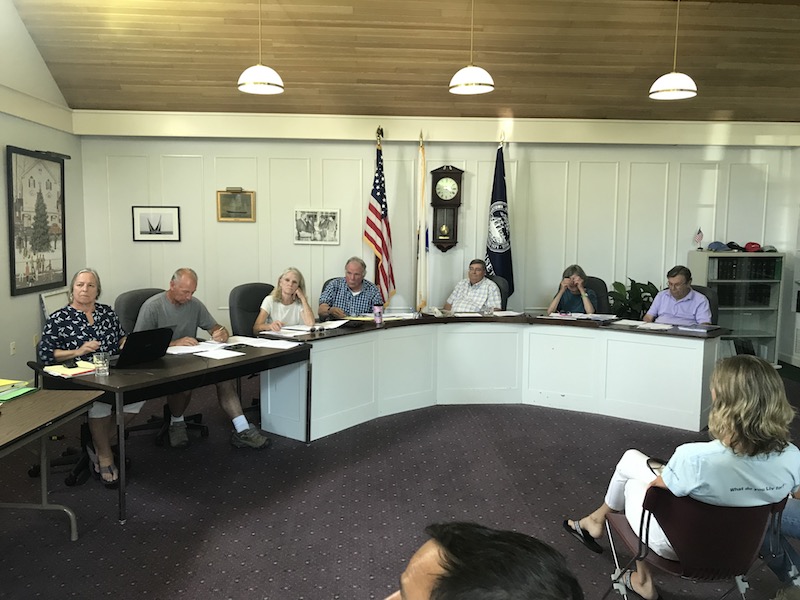Developers who plan to build the nation’s first industrial-scale offshore wind farm south of Martha’s Vineyard saw their first major setback this week, when the Edgartown conservation commission voted to deny the construction of two undersea cables that would connect the 84-turbine, 800-megawatt wind farm to mainland Massachusetts.
The conservation commission voted 5-1 Wednesday night to deny the cables.

The surprising vote puts the giant renewable energy development on hold and marks the first denial of a project that has already received approval from a half-dozen regulatory agencies throughout the Cape and Islands, including the Cape Cod Commission, the Nantucket conservation commission, and the Martha’s Vineyard Commission.
But after hearing hours of testimony from about a dozen fishermen at a hearing two weeks ago, the conservation commission arrived at a different conclusion Wednesday.
Commissioners said their concerns with the project’s unknowns outweighed the potential benefits represented by the wind farm’s substantial investment in renewable energy.
“This is new stuff,” said commissioner Jeff Carlson. “I think it needs more work, and we’re right in the crosshairs of it.”
Under the Massachusetts Wetlands Protection Act, the portion of the undersea cables that would run approximately one mile off the eastern shore of Chappaquiddick fall under the jurisdiction of the conservation commission.
Reached by telephone after the vote, Vineyard Wind spokesman Scott Farmelant could not immediately say whether the company would appeal the decision. He confirmed that this was the project’s first denial during the extensive ongoing permitting process.
In a statement issued later, Mr. Farmelant reacted neutrally. “Vineyard Wind appreciates the efforts of the Edgartown conservation commission and local stakeholders for its very detailed project review process,” it said in part.
If there is an appeal, it would go to the Massachusetts Department of Environmental Protection (DEP).
Meanwhile, an environmental review of the wind farm at the federal level has also slowed. A statement posted on the Vineyard Wind website on July 10 confirmed that the Bureau of Ocean Energy Management will delay the release of a final environmental impact statement for the wind farm.
“We understand that, as the first commercial scale offshore wind project in the U.S., Vineyard Wind will undergo extraordinary review before receiving approvals,” the statement says in part. “As with any project of this scale and complexity, changes to the schedule are anticipated.”
At the public hearing two weeks ago, the Edgartown conservation commission listened to nearly five hours of back-and-forth testimony that pitted commercial fishermen who depend on the Muskeget Channel’s fish-rich waters for their livelihood against climate activists who felt their own livelihoods were threatened by the existential threat of climate change. More than 20 members of the public spoke, driving a wedge between the two groups, fishermen and climate activists, both focused on different aspects of environmental advocacy.
The heated and at times passionate hearing prompted the commission to close discussion and wait two weeks to vote.
Speaking at length on Wednesday night Mr. Carlson outlined his concerns, most of them rooted in testimony from commercial fishermen during the public hearing.
“I listen to the people who are out there all the time,” he said. “These are guys out there in a boat trying to make a living out there. They know how the current works. They know the sand works, and when I listen to them, and I hear this . . . I just feel unintended consequences are all over this.”
He expressed doubts about Vineyard Wind’s proposed construction timeline and said there were unknowns about the effects of silt displacement on benthic habitats. He also raised further concerns about the cables emerging from the sea floor, citing an incident with a wind farm cable near Block Island.
Representatives from Vineyard Wind countered those claims, saying that the project’s draft environmental impact statement predicted minor environmental disturbance from the cable installation and that the current project bore little resemblance to the one near Block Island. Vineyard Wind plans to bury the cables five to eight feet beneath the seafloor using hydro-plow technology.
Rachel Pachter, a Vineyard Wind employee in charge of the project’s extensive permitting process, said the company was also working on proposed mitigation measures for fishermen, if unintended consequences result from the project.
But in the end commissioners sided squarely with fishermen concerned about the project’s unknowns.
“I rely heavily on testimony from fishermen who are out there every day,” said commissioner Geoffrey Kontje.
Mr. Carlson went further.
“I think everybody is really anxious about global warming, and they are looking past what the unintended consequences of this are to the fisheries of this area,” Mr. Carlson said. “What you don’t know, you don’t know.”
Commissioners then voted to deny the project, with Christina Brown casting the lone dissenting vote. Ms. Brown is a member of the Martha’s Vineyard Commission, which voted unanimously to approve the project earlier this year.
It is not known whether the denial by the conservation commission and delay of the final EIS will affect the schedule for construction on the wind farm, due to begin this year.
The race to build offshore wind farms in both Atlantic and Pacific waters off the U.S. coast has spawned a broad web of new policy and regulatory efforts at the federal level. In southern New England alone there are currently seven offshore wind energy leases totaling more than 900,000 acres. “The demand for wind energy has never been greater,” the acting director of BOEM said in a lengthy message posted last month on the agency’s website titled “The Path Forward for Offshore Wind Leasing on the Outer Continental Shelf.”
Headquartered in New Bedford, Vineyard Wind has also opened an office in Boston and plans to have a small operations center in Vineyard Haven in the Packer wharf complex. The wind farm is expected to generate some employment on the Island, and a workforce training program has begun through ACE MV, the Island adult education program.








Comments (29)
Comments
Comment policy »